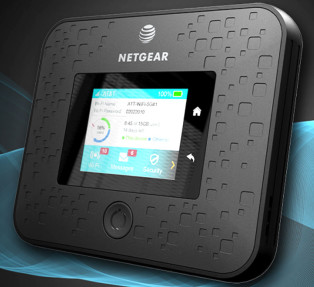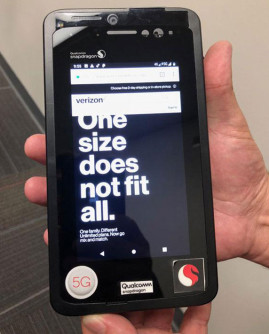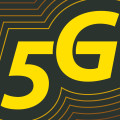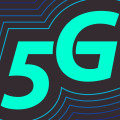Everything 5G
You have questions about 5G. We have answers. Our hub page for everything 5G. Learn the basics, learn what matters and what doesn't, we answer your questions about safety, and all of the latest 5G news in one place.
Intro to 5G Series:
Important Glossary Terms:
5G Phones:
Recent 5G News:

AT&T Says It Used Its Mobile 5G Hotspot to Browse the Web
AT&T today claims that it recently browsed the web using standards-compliant mobile 5G NR mmWave gear. The real-world test took place in Waco, Texas, and included Ericsson networking equipment together with AT&T's forthcoming Netgear Nighthawk 5G Mobile Hotspot. The company connected the 5G hotspot via mmWave to its network and successfully browsed the web on what will eventually be a commercially available device. The Nighthawk relies on the Qualcomm Snapdragon X50 5G modem and will serve as AT&T's very first 5G product. AT&T reiterated that it is on target to launch mobile 5G in 12 markets this year with 19 more to follow in early 2019.
Qualcomm Makes More Progress On 5G NR Tech for Phones
Qualcomm has announced a number of achievements and updates in its work developing 5G NR technologies. First and foremost, the company revealed the second wave of QTM052 mmWave antenna modules with 5G NR specifically for smartphones and other mobile devices. Qualcomm says this new family of antennas is 25% smaller than those announced earlier this year, which will help phone makers fit them into smaller form factors. The reduced-size also gives phone makers more freedom in antenna placement and flexibility when designing their 5G NR devices. The antennas are paired with Qualcomm's Snapdragon X50 5G modem and can fully handle mmWave technologies, such as beam forming, beam steering, and beam tracking. Last, the QTM052 includes a 5G NR radio transceiver, power management IC, RF front-end, and phased antenna array. It can utilize up to 800 MHz of spectrum in various mmWave bands. Qualcomm says this antenna / modem combo will appear in devices in early 2019. In other 5G news, Qualcomm has together with partner Ericsson successfully completed an over-the-air call in sub-6 GHz bands using 3GPP Rel-15 compliant 5G NR in a smartphone phone factor test device. The test was completed in Ericsson's Stockholm lab using 3.5 GHz spectrum. This successful test joins similar ones made using mmWave 5G NR in the 28 GHz and 39 GHz bands. All the tests relied on Ericsson’s 5G NR radio AIR 6488 and baseband products together with Qualcomm's Snapdragon X50 5G modem and RF subsystem. Last, Qualcomm announced that it is working together with Samsung to develop 5G small cells, a vital part of the way 5G networks will be deployed. Small cells will be a building block for 5G with the goal of network densification. The companies plan to pair Qualcomm's FSM 100xx 10nm 5G tech with Samsung's 5G Small Cell form using both sub-6 GHz and mmWave spectrum. The combo will offer MIMO baseband functionality with multi-gigabit throughput speeds in a compact form able to support indoor and outdoor deployments. Qualcomm and Samsung expect to begin sampling this jointly-developed small cell in 2020.

Verizon Says It Has Completed a 5G NR Call with a Phone-Type Device
Verizon Wireless continues to make progress in developing its future 5G network. The latest milestone saw Verizon and partners Ericsson and Qualcomm create a 5G NR call using commercial equipment and a smartphone-sized test device. Previous calls have been made in labs and to vans with the proper equipment. This demonstration shows how 5G NR mobile service will eventually work on phone-sized devices. Verizon says the call was completed over its 39 GHz spectrum with an Ericsson mmWave radio and the Qualcomm Snapdragon X50 modem. Verizon expects to launch fixed 5G service in Los Angeles, Sacramento, Houston, and Indianapolis before the end of the year, with its mobile 5G on deck for early 2019.
AT&T Expanding 5G Trials to More Markets
AT&T today said it plans to test its fixed 5G wireless technology with consumers and businesses in a handful of new markets. It kicked off 5G trials earlier this year in Austin and will expand to Waco, Texas; Kalamazoo, Mich.; and South Bend, Ind. by the end of the year. The company says it has already gained valuable insight regarding millimeter wave (mmWave) technology from its Austin trials, including how well the signal propagates around objects and how it is impacted by weather. It is consistently seeing maximum download speeds of 1 Gbps, though latency is stuck at 10 nanoseconds. AT&T is testing a handful of applications and services. For example, AT&T is allowing DirecTV Now customers to stream live television over this 5G connection using Ericsson's 5G RAN and Intel's 5G Mobile Trial Platform. AT&T didn't say what spectrum it is using to conduct these trials, nor what consumer equipment is involved. The mmWave technology is just one of many candidate 5G technologies being considered by the 3GPP and ITU. The 5G standard has not yet been technically defined by the international community, but that hasn't stopped carriers and telecom equipment manufacturers from forging ahead. The goal with tests such as these is to make enough technical progress so AT&T can contribute to the final 5G spec and get a jump on deployment. AT&T says it expects to deliver 5G speeds as early as late 2018.
AT&T Testing Millimeter Wave 5G Tech in Austin
AT&T today said it has kicked off a second trial of mmWave technology in Austin, providing fixed wireless broadband to consumers and businesses alike with speeds up to 1 Gbps. AT&T is testing a handful of applications and services. For example, AT&T is allowing DirecTV Now customers to stream live television over this "5G" connection using Ericsson's 5G RAN and Intel's 5G Mobile Trial Platform. AT&T had previously made it possible to stream DirecTV Now via mmWave in its Middletown, N.J., laboratory. AT&T expects the trial will last for several months. AT&T didn't say what spectrum it is using to conduct this trial, nor what consumer equipment. The mmWave technology is just one of many candidate 5G technologies being considered by the 3GPP and ITU. The 5G standard has not yet been technically defined by the international community, but that hasn't stopped carriers and telecom equipment manufacturers from forging ahead. The goal with tests such as this is to make enough technical progress so AT&T can contribute to the final 5G spec and get a jump on deployment. AT&T says it expects to "deliver 5G speeds as early as late 2018."
AT&T Not Waiting for 5G Standard, to Offer Consumer Trials
AT&T today laid out more of it is roadmap for 5G and brazenly said it is moving forward despite the lack of standardization for 5G. "We're not waiting until the final standards are set to lay the foundation for our evolution to 5G," said John Donovan, chief strategy officer and group president, Technology and Operations. "We're executing now." AT&T says its data network has seen a 250,000% increase in traffic since 2007, largely driven by video. It feels it needs to move on 5G now in order to accommodate the growing demand for data. The International Telecommunication Union isn't expected to formally ratify 5G until 2020, though some of the broad definitions of 5G have already been defined, such as 1 Gbps speeds and latency under 5 milliseconds. AT&T claims its lab trials have already delivered peak speeds of 14 Gbps with latency as low as 3 milliseconds. It says some portions of its LTE 4G network will offer 1 Gbps (theoretical max) speeds later this year thanks to small cells, densification, and 3- and 4-channel carrier aggregation. AT&T's DirecTV Now customers in Austin, Texas, will be the first to trial AT&T's 5G network technology during the first half of the year. The trial will involve fixed wireless 5G using mmWave in a handful of locations with a handful of devices in the Austin area. The tests may begin as soon as March. The company has been testing this same technology with Intel and Ericsson in Austin since last fall and says it saw consistent 1 Gbps speeds. AT&T plans more 5G trials this year in the 28 GHz and 39 GHz bands using the framework developed so far by the 3GPP.
AT&T to Test '5G' In the Field with Intel
AT&T today announced an expansion of its 5G trials with its first business customer. Intel has agreed to test AT&T's mmWave technology at its own Austin-based offices. AT&T and its technology partner, Ericsson, claim to have reached peak download speeds of 14 Gbps with 4K HD video and real-time camera feeds. This field trial will put business-class use-cases to the test, including internet access, VPNs, unified communications, and 4K video streams in the 15 GHz and 28 GHz spectrum bands. "Mobile video streaming continues to be a vital aspect of our 5G work, and this trial gives us an opportunity to test 4K HD video streaming across further physical distances between pieces of equipment," said Tom Keathley, AT&T's senior vice president, wireless network architecture and design. AT&T says the field trial will bring it one step closer to deployment. Until now, it has been testing its 5G technologies in the lab and some real-world spaces in Texas, Georgia, New Jersey, and California. AT&T hopes its technological path will help it contribute to the international 5G standard, which has yet to be defined by the ITU.
AT&T Expands 5G Trials, Claims 10Gbps Speeds
AT&T today announced plans to extend its 5G testing to three more cities. AT&T will continue to test in Austin, Texas, and will also begin testing in Atlanta, Ga., Middletown, N.J., and San Ramon, Calif. AT&T says it recently reached a milestone in testing: it pushed speeds higher than 10Gbps with partner Ericsson. AT&T's tests are all being performed in labs, though the company says its labs are able to simulate real-world environments and scenarios. For example, AT&T can test how its 5G network might react at a sporting event, where a large number of customers might connect at the same time. Aside from speed, latency is an important aspect of 5G. AT&T says its early latency tests are promising, though it declined to share any numbers. Latency needs to be as close to zero as possible for situations such as self-driving cars, so they may react appropriately to unexpected changes in driving conditions. AT&T believes it will move to outdoor testing of fixed locations in Austin and Middletown by the end of the summer. The company hopes its progress will help it contribute to the international 5G standard, which has yet to be defined. Last, AT&T said it has added partner Nokia to the list of vendors helping it with 5G. Nokia is, specifically, researching millimeter wave spectrum use, beamforming, and higher levels of throughput.
Verizon Looking to Be First to Deploy 5G
Verizon Wireless wants to stay ahead of the curve and be among the first to launch fifth-generation (or 5G) wireless network technology. The company plans to begin field tests at its Innovation Centers, which are dedicated sandboxes for testing apps and services, located in San Francisco and Waltham, Mass., at some point in 2016. Verizon will use gear supplied by partners Alcatel-Lucent, Ericsson, Cisco, Nokia, Qualcomm, and Samsung to conduct the trials. Moreover, Verizon expects to reach "some level of commercial deployment" as soon as 2017, according to Roger Gurnani, chief information and technology architect for Verizon. Verizon's timeline is ambitious, especially considering 5G hasn't been defined. The International Telecommunications Union only agreed on the basic framework for developing what will eventually become the 5G wireless data specification in June of this year. The 5G roadmap is being referred to as IMT-2020, which the ITU hopes to have finalized by the year 2020. The core definition of 5G will be wireless networks that can transmit data at speeds up to 20Gbps. Most of today's LTE networks are allowing for connections as fast as 50Mbps in real-world conditions. Verizon's Gurnani said the company is targeting real-world speeds that are 30 to 50 times faster than current LTE 4G. Verizon didn't say if it intends to adhere to the ITU's vision for what 5G technology should truly be. Verizon is the first U.S. network operator to put 5G on its public roadmap, but others are sure to follow quickly.


 What is 5G? The Basics
What is 5G? The Basics
 Is 5G Safe?
Is 5G Safe?
 10 Reasons You Can Ignore 5G (for now)
10 Reasons You Can Ignore 5G (for now)

